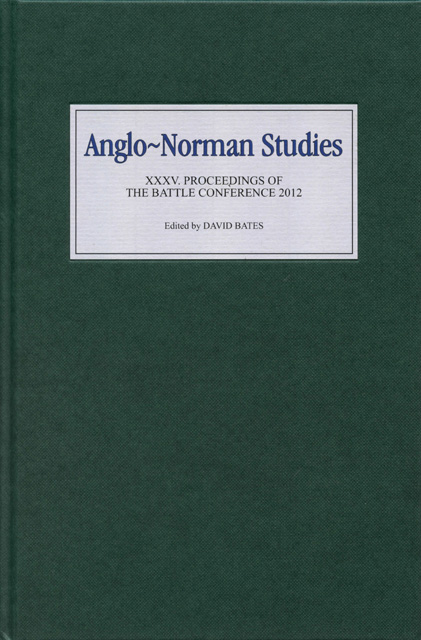Book contents
- Frontmatter
- Dedication
- Contents
- List of Illustrations and Tables
- Editor’s Preface
- Abbreviations
- A Three-Cornered Dynamic of Redemption in the ‘Long’ Thirteenth Century: Villein Manumissions and the Theology of the Incarnation (The R. Allen Brown Memorial Lecture, 2011)
- Femmes en religion, personnes d’autorité: les abbesses normandes (XIe–XIIIe siècles) (The R. Allen Brown Memorial Lecture, 2012)
- The Role of the Curator of the Bayeux Tapestry
- Early Normandy
- The Norman Conquest, Countess Adela, and Abbot Baudri
- Baldric of Bourgueil and the Flawed Hero
- John Bilson (1856–1943) and the Study of Anglo-Norman Romanesque
- The Identity of the Designer of the Bayeux Tapestry
- The Pseudo-Hugh Falcandus in His Own Texts
- The Thirteenth-Century Chronique de Normandie
- Les investitures abbatiales en Normandie: quelques réflexions autour du cas de l’abbaye du Bec-Hellouin (1034–1136)
- Robert Curthose: The Duke Who Lost His Trousers
- Sufficientia: A Horatian Topos and the Boundaries of the Self in Three Twelfth-Century Poems
- Aristocratic Acta in Normandy and England, c. 1150–c. 1250: The Charters and Letters of the Du Hommet Constables of Normandy
- Crime without Punishment: Medieval Scottish Law in Comparative Perspective
- Landscape and Belief in Anglo-Norman England
- Contents of Volumes 1–34
The Identity of the Designer of the Bayeux Tapestry
Published online by Cambridge University Press: 28 February 2023
- Frontmatter
- Dedication
- Contents
- List of Illustrations and Tables
- Editor’s Preface
- Abbreviations
- A Three-Cornered Dynamic of Redemption in the ‘Long’ Thirteenth Century: Villein Manumissions and the Theology of the Incarnation (The R. Allen Brown Memorial Lecture, 2011)
- Femmes en religion, personnes d’autorité: les abbesses normandes (XIe–XIIIe siècles) (The R. Allen Brown Memorial Lecture, 2012)
- The Role of the Curator of the Bayeux Tapestry
- Early Normandy
- The Norman Conquest, Countess Adela, and Abbot Baudri
- Baldric of Bourgueil and the Flawed Hero
- John Bilson (1856–1943) and the Study of Anglo-Norman Romanesque
- The Identity of the Designer of the Bayeux Tapestry
- The Pseudo-Hugh Falcandus in His Own Texts
- The Thirteenth-Century Chronique de Normandie
- Les investitures abbatiales en Normandie: quelques réflexions autour du cas de l’abbaye du Bec-Hellouin (1034–1136)
- Robert Curthose: The Duke Who Lost His Trousers
- Sufficientia: A Horatian Topos and the Boundaries of the Self in Three Twelfth-Century Poems
- Aristocratic Acta in Normandy and England, c. 1150–c. 1250: The Charters and Letters of the Du Hommet Constables of Normandy
- Crime without Punishment: Medieval Scottish Law in Comparative Perspective
- Landscape and Belief in Anglo-Norman England
- Contents of Volumes 1–34
Summary
‘Everything ultimately revolves around the nameless figure of the artist in charge.’ How right this sentiment is, apart from the fact that he (or she) need not remain nameless! By its nature the Bayeux Tapestry is a work of art that is partly visual and partly narrative and that contains numerous political statements and implicit social commentary. If we could identify the person who was primarily responsible for so much invaluable historical material, questions of an interpretative nature could more easily and more accurately be answered. And if serious study of the artefact goes back to Dom Bernard de Montfaucon’s first two volumes, published in 1729–30, it will have taken the best part of two centuries to resolve this basic question.
The identity of the designer of the Bayeux Tapestry was described in 1962 as ‘one of the most puzzling in medieval art history’. In terms of this question, I am adopting as an initial baseline two essays by Richard Gameson (1997) and jointly by Elizabeth Pastan and Stephen White (2009) in a volume of ‘new interpretations’. By stating conclusions that I reached independently back in the mid-1990s, they would seem to have come close to the truth. To some extent, I shall be pushing the boundary forward from the point at which they chose to leave it. Other scholars, too, have come close on certain aspects, but none that I am aware of has published all of the necessary joined-up thinking.
The Bayeux Tapestry presents a joined-up narrative (quite literally, in nine pieces or sections) that requires joined-up thinking in order to interpret its nature and meaning (Table 1). Being a visual object, it raises the phenomenon of how humans ‘see’ things. A familiar observation is that, in the event of a road accident witnessed by five people, the investigating police come up with five different accounts of what happened. We all see things selectively, influenced more than we imagine by our subconscious minds. Incidentally, in this context C. R. Dodwell, one of the best commentators on the art-historical side, remarked that most artistic influences are subconscious rather than conscious.
- Type
- Chapter
- Information
- Anglo-Norman Studies 35Proceedings of the Battle Conference 2012, pp. 119 - 140Publisher: Boydell & BrewerPrint publication year: 2013
- 8
- Cited by



